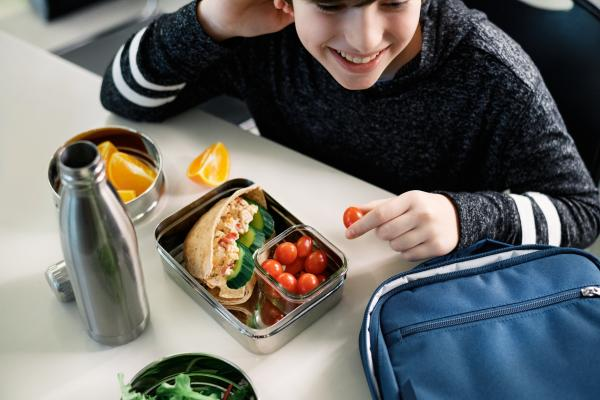 Image Health Canada
Image Health Canada
Back-to-school is in full swing, including educational opportunities for dietitians and food professionals! We attended an international seminar on back-to-school success with USDA’s Team Nutrition.[1] As you may know the US funds school lunch programs and has a robust support system – both financial and practical – for feeding kids in schools. We discovered some amazing new content, lots of tips and highlights that you can use to nourish students whether you’re a parent, educator, or foodservice professional.
Scientists and health professionals agree on the importance of healthy eating at school to optimize health, development, and academic performance. Since children and youth spend a large portion of their day in school, they consume a significant proportion of their daily energy intake while in school.[2],[3] This means it’s key to provide food for students that gives them enough energy and nutrients they need throughout the day.
Here are some tips for your school’s food and nutrition program to help kids grow up healthy:
Food Focus
- Align school nutrition policies with recommendations in Canada’s Food Guide and promote nutrient-rich foods and beverages that are lower in saturated fat, sugars, and sodium.
- Involve students in the menu development to find the right balance of nutritious foods that are ‘fan favorites’ that kids are going to eat. [4]
- Encourage student taste-testing and get their feedback on food items created by chefs.
- Monitor food waste. Are you watching what foods kids throw away? Finding the reason why kids are not eating their lunch provides insights for creating lunches they will enjoy eating.
- Reach out to a dietitian for support with healthy delicious recipes and meal plans for kids, analyzing recipes and menus to meet school food nutrient standards.
Make an impact beyond the food
- Provide a safe space to enjoy all foods without fear of food judgement.
- Advocate for sufficient time for eating lunch. Experts recommend students have at least 20 minutes of seated time to enjoy their meal and socialize. [5]
- Find out if there is a health committee you can join or start one for your school.
- Invest in educating your school community about how to build healthy relationships with food. A dietitian can help. Ask them about resources to teach nutrition in the classroom, parent resources on packing lunches, school presentations, and referrals for student nutrition programs.[6]
As Dietitians we look beyond fads to deliver reliable, life-changing advice. Do you want to unlock the potential of food? Connect with us with your comments or questions.
Written by Lucia Weiler, BSc, RD, PHEc – Award-winning dietitian and Co-Founder, n4nn
Tags; Foodservice management, back to school, school nutrition policy, student nutrition, dietitian, Lucia Weiler, n4nn
[1] United States Department of Agriculture (USDA) Food & Nutrition Service (2022) https://www.fns.usda.gov/team-nutrition
[2] Health Canada (2021) Healthy eating at school – Canada’s Food Guide
[3] Canadian Paediatric Society (2020) School nutrition: Support for providing healthy food and beverage choices in schools
[4] ABC News (2022) Chicago Public Schools lunch menu https://abc7chicago.com/cps-school-lunch-menu-chicago-public-schools/12213616/
[5] CDC (2019) Making Time for School Lunch https://www.cdc.gov/healthyschools/nutrition/school_lunch.htm
[6] Dietitians of Canada (2019) Eating Right at School. https://www.unlockfood.ca/en/Articles/School-Health/Articles/Eating-Right-at-School.aspx

Contact us for comments or questions.